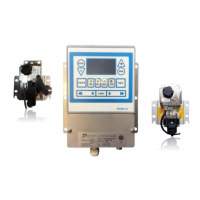Page: 49
f) Verify that the display is showing 0 to 2 ppm. If this is the case, continue with the steps
r) to t).
12.3 Cleaning Process
g) Stop any water flow.
For instruments equipped with Automatic Cell Cleaning Device, shut off the
instrument air.
h) Unscrew and remove the Cell Cap. Visually check the wiper piston and the O - Rings
for wear or damage.
i) The wiper seal should be clean.
j) It is recommended to clean the Measuring Cell on a regular schedule manually using
the Cell Cleaning Brush with upwards and downwards motion through the entire
length of the cell several times.
k) For oily deposits use a mild detergent on the Cell Cleaning Brush.
l) Put back the Cell Cap, and the wiper piston. Make sure that the Cell Cap is screwed in
completely.
m) Purge with oil free water for several minutes to get a clean Measuring Cell.
n) Verify that the display is showing 0 to 2 ppm.
o) For instruments equipped with Automatic Cell Cleaning Device, restore the air.
p) Turn on the sample water flow.
12.4 Intensive Cleaning
q) If there is no improvement, repeat cleaning with the Cell Cleaning Brush and use
Sample Tube Cleaner and check in contemporary the display, if the “0” point is
achieved. The process could take about 5 minutes. Shouldn´t the result improves
again, use Citric Acid and let act on over the night.
- Cut the upper part of the Cell Cleaning Brush.
- Insert the wire stem of the Cell Cleaning Brush into a screwdriver and fix it.
- Slowly rotate the Cell Cleaning Brush for a few minutes in the Sample Glass Tube.
- Flush with clean water and re-test
For more information, see section 24.1 Servicing and Cleaning Manual.
12.5 System Test
r) Perform a “System Test” for checking the alarms contacts. See section 21.2.1
Functional Button “TEST”.

